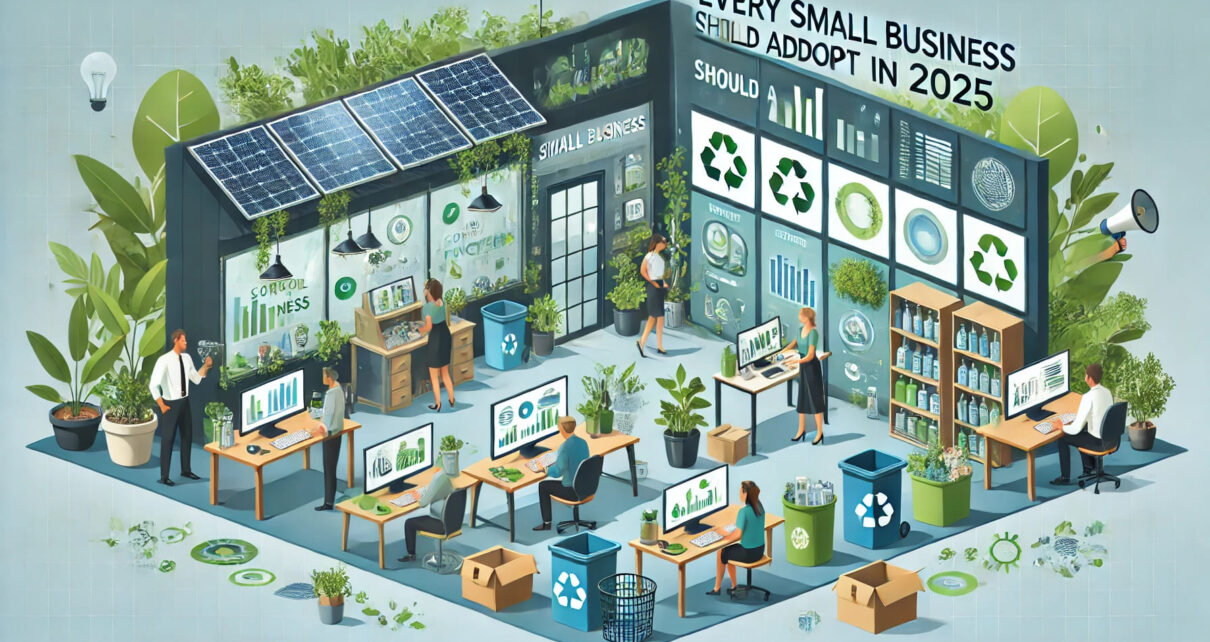In 2025, the importance of sustainability for small businesses has reached unprecedented levels. Amid growing environmental concerns and stricter regulations, small businesses must prioritize eco-friendly practices to stay competitive, reduce costs, and meet consumer expectations. By embedding sustainability into their operations, businesses not only contribute to a healthier planet but also secure long-term profitability.
Table of Contents
Understanding Sustainability in Business
Sustainability in business refers to adopting practices that meet present needs without compromising the ability of future generations to meet theirs. It encompasses three pillars: economic, social, and environmental sustainability. Small businesses play a crucial role in this movement by reducing their environmental impact, supporting community welfare, and ensuring economic resilience.
The Importance of Sustainability for Small Businesses
- Cost Efficiency: Sustainable practices often lead to significant cost reductions, such as saving on energy, waste management, and operational inefficiencies, ultimately improving profitability.
- Improved Brand Image: Consumers prefer brands that align with their values, making sustainability a competitive differentiator and fostering long-term customer loyalty and trust.
- Regulatory Compliance: Governments worldwide are enforcing stricter environmental laws, making compliance critical to avoid penalties, litigation, and reputational damage, while also enhancing business longevity.
Current Trends in Sustainable Business Practices
In 2025, businesses are increasingly adopting:
- Circular Economy Models: Prioritizing reuse, recycling, and sustainable sourcing to reduce waste, optimize resource use, and promote product lifecycle longevity.
- Renewable Energy: Transitioning from fossil fuels to solar, wind, and hydropower to reduce carbon footprints, lower energy costs, and improve environmental stewardship.
- Digital Operations: Leveraging technology to minimize resource waste, improve operational efficiency, and foster transparency in processes, creating more sustainable business practices.
Energy Efficiency and Renewable Energy

Small businesses can significantly reduce their carbon footprint by focusing on energy efficiency and renewable energy adoption.
Investing in Energy-Efficient Appliances
Modern appliances with high energy ratings consume less electricity, leading to lower utility bills and reduced emissions. Businesses can prioritize LED lighting, energy-saving HVAC systems, and energy-efficient office equipment to reduce operational costs. Additionally, these upgrades can improve workplace comfort, enhance productivity, and demonstrate environmental responsibility to stakeholders.
Switching to Renewable Energy Providers
Partnering with renewable energy suppliers or installing solar panels can cut costs, reduce environmental impact, and demonstrate a strong commitment to sustainability. Governments often provide incentives, such as tax credits and grants, for such transitions, further reducing the financial burden and helping businesses to become more resilient and future-proof.
Reducing Waste and Recycling
Waste reduction and recycling are critical components of sustainable operations, helping businesses minimize their environmental impact while optimizing resource use. By focusing on waste diversion, small businesses can reduce landfill contributions and often save on disposal costs, contributing to both environmental preservation and cost efficiency.
Adopting Circular Economy Principles
Businesses can minimize waste by repairing, reusing, and recycling materials, aligning with circular economy principles. For instance, furniture refurbishing, reusing packaging, or repurposing old equipment instead of disposal helps reduce the consumption of raw materials and limits waste. This approach not only supports sustainability but can also open new revenue streams through creative repurposing of assets.
Implementing Office Recycling Programs
Setting up dedicated bins for paper, plastics, and electronics while educating employees about proper recycling practices fosters a culture of sustainability within the organization. Additionally, implementing digital systems to track waste reduction efforts and providing incentives for eco-friendly behavior can increase participation and demonstrate a business’s commitment to sustainability.
Sustainable Supply Chain Management

By focusing on sustainability in their supply chains, businesses ensure that their products are ethically sourced and environmentally friendly.
Partnering with Eco-Friendly Vendors
Evaluate suppliers based on their sustainability credentials, such as using renewable energy, eco-friendly materials, or minimizing waste in production processes. Partnering with vendors who prioritize environmental and social responsibility enhances the entire value chain, reduces the ecological footprint of products, and strengthens the business’s sustainability profile.
Promoting Local Sourcing
Sourcing from local vendors reduces transportation emissions, cuts down on the carbon footprint associated with long-distance shipping, and supports local economies. By prioritizing local suppliers, businesses can foster community goodwill, enhance product traceability, and often benefit from fresher, higher-quality goods while reducing their impact on the environment.
Digital Transformation and Paperless Operations
A move toward digital processes is one of the most effective ways for small businesses to cut waste.
Switching to Cloud-Based Systems
Cloud storage eliminates the need for physical filing systems, reducing paper use and associated costs such as printing, storage, and shredding. It also improves data security and accessibility, making it easier for teams to collaborate remotely. Collaboration tools like Google Workspace and Microsoft Teams not only enhance productivity but also reduce environmental impact by limiting the need for paper and office supplies.
Adopting E-Invoicing and Digital Marketing
Paperless invoicing saves valuable resources and streamlines financial processes, reducing the need for printing, mailing, and storing paper documents. Digital marketing, including email campaigns, social media, and online ads, reduces the need for printed promotional materials, lowering costs and waste while reaching a broader, more targeted audience.
Employee Engagement in Sustainability
Involving employees in sustainability initiatives fosters a shared sense of purpose and responsibility.
Workplace Green Policies
Develop guidelines that encourage energy-saving behaviors, such as turning off lights, computers, and other equipment when not in use, and reducing paper waste through digital communication. These policies can also include waste segregation, water conservation measures, and promoting the use of sustainable materials. Encouraging employees to participate in such practices helps reduce the business’s environmental footprint.
Sustainability Training Programs
Regular workshops on eco-friendly practices can empower employees to adopt greener habits both at work and at home. Training programs can cover topics such as energy conservation, waste reduction, sustainable transportation options, and eco-friendly consumption. By providing the knowledge and tools, businesses can inspire employees to contribute to sustainability initiatives more effectively.
Sustainable Transportation Solutions
Transportation is a significant contributor to carbon emissions, making it an area ripe for improvement.

Promoting Public Transport and Carpooling
Encouraging staff to use public transportation, carpool, or cycle to work can significantly reduce the business’s environmental impact by lowering the number of single-occupancy vehicles on the road. Offering incentives such as subsidies for public transport passes, carpool programs, or bike storage can further promote sustainable commuting and reduce the overall carbon footprint of the workforce.
Adopting Electric Vehicles for Business Operations
Switching to electric vehicles (EVs) for deliveries or company cars is not only eco-friendly but also cost-effective in the long run. EVs have lower maintenance costs, reduce fuel expenses, and are eligible for government subsidies or tax credits, making the transition financially advantageous. In addition, using EVs enhances the company’s sustainability profile and positions the business as a leader in green innovation.
Water Conservation Strategies
Efficient water management is another critical aspect of sustainability.
Fixing Leaks and Installing Water-Saving Devices
Simple measures like repairing leaks and using water-efficient faucets, toilets, and showerheads can drastically cut water waste and reduce utility bills. Installing motion-sensor faucets, low-flow devices, and efficient irrigation systems can further minimize water use while maintaining functionality and comfort in the workplace.
Rainwater Harvesting Systems
Collecting and reusing rainwater for landscaping, irrigation, or cleaning purposes reduces dependency on municipal water supplies and helps conserve potable water. By installing rainwater harvesting systems, businesses can not only cut water costs but also improve their sustainability practices, making a positive impact on both the environment and their bottom line.
Leveraging Green Certifications
Green certifications validate a business’s commitment to sustainability and can attract environmentally conscious customers.
Popular Green Certifications to Consider
Programs like LEED (Leadership in Energy and Environmental Design), B-Corp, and Green Seal offer recognition for sustainable operations, from energy-efficient buildings to environmentally friendly products and services. Each certification has specific criteria, but all emphasize sustainable practices, social responsibility, and environmental stewardship.
Steps to Achieve Certification
Adopting best practices in sustainability, such as reducing energy consumption, minimizing waste, and sourcing responsibly, is a crucial first step. Maintaining comprehensive documentation to track progress, improve transparency, and ensure compliance with certification standards is essential. Finally, undergoing third-party audits or assessments provides an objective review of a business’s sustainability efforts, helping businesses achieve and maintain certification while fostering continuous improvement.
Measuring and Reporting Sustainability Performance
Regular evaluation and transparent reporting of sustainability efforts build trust and accountability.
Using Carbon Footprint Calculators
Online tools, such as carbon footprint calculators, help businesses measure their environmental impact by quantifying emissions from energy use, transportation, and other operational activities. These tools provide valuable insights into a business’s carbon footprint, enabling them to identify areas for improvement, set reduction targets, and adopt strategies to lower emissions over time.
Annual Sustainability Reports
Publishing annual sustainability reports on goals, progress, and achievements highlights the business’s dedication to environmental responsibility. These reports typically cover key performance indicators (KPIs), such as energy consumption, waste management, and carbon reduction efforts, and demonstrate the company’s commitment to transparency, which can strengthen relationships with customers, investors, and regulatory bodies.
Incorporating Sustainability into Marketing
Eco-conscious marketing not only attracts customers but also reinforces a business’s commitment to sustainability.

Eco-Branding Strategies
Highlighting sustainable practices in branding—such as eco-friendly packaging, renewable energy usage, or waste reduction efforts—can set a business apart from competitors. These strategies not only appeal to environmentally conscious consumers but also showcase a company’s dedication to sustainability. Effective eco-branding communicates a clear message about the business’s environmental values, fostering brand trust and recognition.
Green Product Labeling and Transparency
Clear labeling of products as “eco-friendly,” “sustainably sourced,” or “carbon neutral” ensures consumers make informed choices. Transparency in product ingredients, sourcing practices, and environmental impacts builds credibility and helps consumers align their purchasing decisions with their values. Additionally, businesses that embrace transparency in their sustainability efforts are more likely to gain consumer trust and loyalty.
The Future of Sustainability for Small Businesses
As sustainability becomes a key focus in business operations, small businesses will need to adapt to new trends and technologies to stay competitive. The future of sustainability will involve greater integration of innovative solutions, a shift in consumer behavior, and evolving regulations that prioritize environmental and social responsibility.
Technological Innovations Driving Sustainability
Emerging technologies, such as AI-powered energy management systems, are enabling businesses to optimize energy use and reduce waste more efficiently. Blockchain technology is also enhancing supply chain transparency, allowing businesses to track the sustainability of their products from source to consumer. These innovations provide small businesses with powerful tools to reduce their environmental footprint, improve operational efficiency, and build consumer trust in their sustainability practices.
Legislation and Consumer Expectations
Governments are increasingly introducing stricter environmental regulations, requiring businesses to adopt sustainable practices or face penalties. At the same time, consumers are becoming more conscious of the environmental impact of their purchases, demanding greater transparency and eco-friendly options. Small businesses that proactively adopt sustainable practices will not only comply with legislation but also meet consumer expectations, gaining a competitive edge in a rapidly evolving market.
Conclusion: Embracing a Sustainable Future
Incorporating sustainable practices is no longer optional—it’s a necessity. From energy efficiency to waste reduction, small businesses have numerous opportunities to make a positive impact. By embracing these changes, businesses not only contribute to a healthier planet but also ensure their own growth and success in a rapidly changing world.
FAQs
Why should small businesses prioritize sustainability in 2025?
Sustainability offers a range of benefits for small businesses in 2025. It can help reduce operational costs through energy efficiency and waste reduction. It also improves brand reputation, as consumers are increasingly attracted to businesses that prioritize environmental and social responsibility. Regulatory compliance is another crucial factor, as governments are implementing stricter environmental laws. Additionally, sustainability meets evolving consumer expectations for responsible business practices, building loyalty and attracting eco-conscious customers.
What are simple ways to start with sustainability?
Small businesses can start their sustainability journey with simple actions such as investing in energy-efficient appliances to lower energy consumption. Implementing recycling programs helps reduce waste and encourages a sustainable office culture. Another key step is digital transformation—moving to cloud storage and paperless processes, which can drastically cut paper waste and improve operational efficiency. These initial changes can have a significant positive impact on both the environment and business operations.
How can small businesses afford renewable energy?
Small businesses can make the switch to renewable energy more affordably by leveraging government incentives such as tax credits, grants, and rebates that reduce the initial investment. Additionally, partnerships with renewable energy providers can help small businesses secure favorable pricing for solar or wind energy. These incentives and partnerships make transitioning to renewable energy more financially viable and can lead to long-term savings on energy costs.
What is the role of employees in sustainability?
Employees play a crucial role in driving sustainability within a business. They can champion eco-friendly practices by adopting sustainable habits, such as reducing energy use, minimizing waste, and promoting recycling. Employees can also contribute ideas for sustainability initiatives and participate in training programs to better understand the company’s environmental goals. Their involvement can help create a culture of sustainability that improves energy efficiency, reduces waste, and enhances the business’s overall environmental performance.
How do certifications help businesses?
Sustainability certifications such as LEED, B-Corp, and Green Seal can significantly enhance a business’s credibility by providing an independent, third-party validation of their environmental and social efforts. These certifications help attract eco-conscious customers who prioritize sustainable products and services. They can also open up new market opportunities by making businesses eligible for environmentally focused contracts, partnerships, and collaborations, boosting their competitive edge in an increasingly sustainability-driven market.
What trends will shape sustainability beyond 2025?
In the years following 2025, emerging technologies such as AI, blockchain, and IoT will continue to play a major role in advancing sustainability efforts, enabling businesses to optimize their operations and reduce their environmental footprints more efficiently. Stricter regulations will push businesses to adopt more sustainable practices or face penalties, and evolving consumer preferences for environmentally responsible products and services will continue to drive demand for businesses to align with sustainability goals. These factors will push businesses to stay innovative and adapt to the changing landscape of sustainability.




